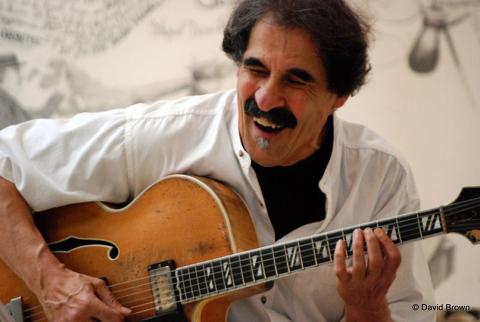Faculty Profile: Jon Damian ’74

Jon Damian ’74
“I wanted students who were having a tough time with the theoretical side of music to recognize that there would be difficulty at first,” Damian says. “But as with spoken language, where they had to learn word meanings and pronunciations, musical things that seem so academic could also become as natural as speaking, breathing, or dancing.” In 2015 he codified his ideas in his third book, the self-published volume Fresh Music: Explorations with the Creative Workshop for Musicians, Artists, and Teachers.
Damian’s sharing of his free and uninhibited approach to performing, composing, and overall musical artistry has built lasting bonds with many former students. Some—Bill Frisell ’77, Kurt Rosenwinkel ’90, Wayne Krantz ’76, Joe Cohn ’90, Leni Stern ’80, and others—have developed celebrated careers.
Damian’s artistic leanings predate his interest in music. As a kid growing up in Brooklyn, NY, he was interested in graphic arts. (He didn’t begin playing guitar until high school.) After he graduated, he pursued art at New York City Community College, earning an associate’s degree before being drafted by the U.S. Army.
“I spent 15 months stationed on Okinawa working as an artist for officer’s training battalions drawing leaflets,” Damian recalls. “Then I auditioned for a music gig with the USO and did that until my discharge in 1968. I was offered a nice position at a New York advertising company, but decided to go to Berklee instead to pursue my music dream.
“My musical inspiration came from watching Tony Mottola play guitar with the Tonight Show Orchestra. I liked what he was doing and that he was playing with a lot of celebrities. I decided that’s what I wanted to do.” Damian was a self-taught guitarist, and reading music was the first thing he taught himself. “I’d worked hard enough at it so that when I got to Berklee, my guitar teacher, Frank Turziano, began recommending me for top-of-the-line gigs. Being literate on the guitar opened doors for me.”
Damian began playing musicals at Boston theaters. Gigs with the Boston Pops Orchestra, Boston Opera Company, and Boston Ballet followed. Eventually, he was playing shows backing celebrity artists such as Carol Channing, Nancy Wilson, Linda Ronstadt, Doc Severinson, Trini Lopez, Jerry Lewis, and many others, just as he’d seen Mottola do.
As a composition major, Damian studied with Herb Pomeroy, Jeronimas Kacinskas, John Bavicchi, and John LaPorta. During his final year as a student, he joined the faculty and taught ensembles. The idea for his creativity ensemble grew out of experiences with drummer Billy Elgart ’63 and bassist John Voigt (then Berklee’s librarian). “They used to take me to play with their avant ensembles,” Damian states. “I remember trying to play really weird stuff to wow them, but this music wasn’t about that, it was about playing off things and building from there. Those experiences taught me to find myself and play in the moment. Voigt was open to inspiration from anything in the universe from alphabets to zodiacs. I was really gassed by that, and it spawned the creative workshop.”
A Damian trademark invention, the “Rubbertellie,” has been his vehicle for improvisations that often blend music, painting, and performance art. He uses a standard Fender Telecaster guitar, but calls it “rubber” because he stretches the guitar’s parameters in tuning and playing technique. “I play it in a nonstandard way,” he says. “Sometimes I hold it like a cello and other times it’s on my lap. For the Rubbertellie Murals, I produce paintings while sitting with the instrument’s neck upright, and on either side of it are tables with bowls of paint. There is a roll of paper that passes in between the strings and the fingerboard, pulled by stagehands. I dip my fingers in the paint and play percussively on the guitar neck. The paintings look like something from a seismograph.”
Damian has performed and lectured across the globe. At Australia’s Northern Melbourne Institute at Tafe, he gave a three-hour demonstration on the Rubertellie for the art department. “I created 15 murals on themes the people threw out to me,” he says. “I did one using the Olympic colors, one on birds, and another giving my take on a boring lecture from the night before. And the people got it!”
Damian has also promoted a service ethic among his students. Acting as the faculty adviser to the student club GARAGE (General Association of Really Astute Guitar Enthusiasts), he coordinated an annual “garage” sale with items donated by faculty and staff members. One year, funds went to Haitian earthquake victims and another year to a student needing a new guide dog. For years, his Performance Outreach Program (POP) brought students to audiences at hospitals and prisons. In 1993, Boston mayor Ray Flynn noted Damian’s efforts with the city’s Pro Arts Public Service in the Arts award.
Some of Damian’s recent creative projects have been quite personal. “In 2016, I was isolated in a room at Beth Israel Deaconess Hospital for 38 days after a stem-cell transplant for leukemia,” he says. “To pass the time, I wrote and illustrated two children’s books for my grandchildren and wrote a piece called “Saints and Angels” dedicated to the medical staff there. Bill Frisell adapted it for his quartet with guitar, violin, viola, and cello and has been playing it around the world.”
Damian views writing and teaching performance arts as comparable to dance, musical performance, or acting. “It’s all show business,” he says. Perhaps, show biz from the soul of an artist.




